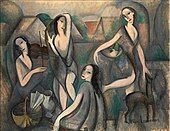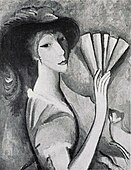art.wikisort.org - Artist
Marie Laurencin (31 October 1883 – 8 June 1956) was a French painter and printmaker.[1] She became an important figure in the Parisian avant-garde as a member of the Cubists associated with the Section d'Or.
Marie Laurencin | |
|---|---|
 Marie Laurencin, c. 1912, Paris | |
| Born | 31 October 1883 Paris, France |
| Died | 8 June 1956 (aged 72) Paris, France |
| Known for | Painter |
| Movement | Cubism |
This article may be expanded with text translated from the corresponding article in French. (June 2020) Click [show] for important translation instructions.
|
Biography
Laurencin was born in Paris,[2] where she was raised by her mother and lived much of her life. At 18, she studied porcelain painting in Sèvres. She then returned to Paris and continued her art education at the Académie Humbert, where she changed her focus to oil painting.

During the early years of the 20th century, Laurencin was an important figure in the Parisian avant-garde. A member of both the circle of Pablo Picasso, and Cubists associated with the Section d'Or, such as Jean Metzinger, Albert Gleizes, Robert Delaunay, Henri le Fauconnier and Francis Picabia, exhibiting with them at the Salon des Indépendants (1910-1911) and the Salon d'Automne (1911-1912), and Galeries Dalmau (1912) at the first Cubist exhibition in Spain. She became romantically involved with the poet Guillaume Apollinaire, and has often been identified as his muse. In addition, Laurencin had important connections to the salon of the American expatriate and lesbian writer Natalie Clifford Barney. She had relationships with men and women,[3] and her art reflected her life, her "balletic wraiths" and "sidesaddle Amazons" providing the art world with her brand of "queer femme with a Gallic twist."[4]
During the First World War, Laurencin left France for exile in Spain with her German-born husband, Baron Otto von Waëtjen, since through her marriage she had automatically lost her French citizenship. The couple subsequently lived together briefly in Düsseldorf. She was greatly affected by her separation from the French capital, the unrivaled center of artistic creativity.[5] After they divorced in 1920, she returned to Paris, where she achieved financial success as an artist until the economic depression of the 1930s. During the 1930s she worked as an art instructor at a private school. She lived in Paris until her death.
Work
Laurencin's works include paintings, watercolors, drawings, and prints. She is known as one of the few female Cubist painters, with Sonia Delaunay, Marie Vorobieff, and Franciska Clausen.[citation needed] While her work shows the influence of Cubist painters Pablo Picasso and Georges Braque, who was her close friend, she developed a unique approach to abstraction which often centered on the representation of groups of women and animals. Her work lies outside the bounds of Cubist norms in her pursuit of a specifically feminine aesthetic by her use of pastel colors and curvilinear forms. Originally influenced by Fauvism, she simplified her forms through the influence of the Cubist painters. From 1910, her palette consisted mainly of grey, pink and pastel tones.[6]
Her distinctive style developed upon her return to Paris in the 1920s post exile. The muted colours and the geometric patterns inherited from Cubism were replaced by light tones and undulating compositions.[7] Her signature motif is marked by willowy, ethereal female figures, and a palette of soft pastel colours, evoking an enchanted world.[8]
Laurencin continued to explore themes of femininity and what she considered to be feminine modes of representation until her death. Her works include paintings, watercolors, drawings, and prints.
- Selected works
- 1910-11, Les jeunes filles (Jeune Femmes, Young Girls), oil on canvas, 115 x 146 cm. Exhibited Salon des Indépendants, 1911, Moderna Museet, Stockholm
- 1911, La Toilette des jeunes filles (Die Jungen Damen), black and white photograph. Exhibited at the 1913 Armory Show, New York, Chicago and Boston
- 1912, Femme à l'éventail (Woman with a Fan), black and white photograph published in Albert Gleizes, Jean Metzinger, Du "Cubisme", Edition Figuière, Paris, 1912
- 1913, Le Bal élégant, La Danse à la campagne
- 1921, Portrait de Jean Cocteau
Collections
Laurencin's artistic accomplishments are seen in collections around the world. On the 100th anniversary of her birth in 1983, the Musée Marie Laurencin opened in Nagano, Japan.[9] To date, the Musée Marie Laurencin is the only museum in the world that solely contains the art of a female painter. Founder Masahiro Takano was enamored with Laurencin's sensual and lyrical worldview, and the museum holds over 600 art pieces by her.
Laurencin's work is also found in The Museum of Modern Art in New York, the Hermitage Museum in St. Petersburg, and the Tate Gallery in London. Her work is also shown in the permanent collection of the Musée de l'Orangerie gallery in Paris, France, housing some of her most famous pieces.
Notes
- Maurice Raynal: Modern French Painters, Ayer Publishing, 1928, ISBN 978-0-405-00735-4, p. 108
- Phaidon Editors (2019). Great women artists. Phaidon Press. p. 233. ISBN 978-0714878775.
{{cite book}}:|last1=has generic name (help) - "Laurençin, Marie". glbtq.com. Archived from the original on 2013-09-21.
- Pilcher, Alex (2017). A Queer Little History of Art. London: Tate Publishing. p. 37. ISBN 978-1-84976-503-9.
- "Musée d'Orsay".
- "Marie Laurencin | Musée de l'Orangerie". www.musee-orangerie.fr. Retrieved 2020-09-27.
- "Musée d'Orsay".
- "Marie Laurencin | Musée de l'Orangerie". www.musee-orangerie.fr. Retrieved 2020-09-27.
- "Sotheby's - Marie Laurencin".
References
- Birnbaum, Paula J. Women Artists in Interwar France: Framing Femininities, Aldershot, Ashgate, 2011.
- Gere, Charlotte. Marie Laurencin, London - Paris, Flammarion, 1977
- Groult, Flora. Marie Laurencin, Paris, Mercure de France, 1987
- Kahn, Elizabeth Louise. "Marie Laurencin: Une Femme Inadaptée" in Feminist Histories of Art Ashgate Publishing, 2003.
- Marchesseau, Daniel. Marie Laurencin, Tokyo, éd. Kyuryudo & Paris, Hazan, 1981
- Marchesseau, Daniel. Marie Laurencin, Catalogue raisonné de l'œuvre gravé, Tokyo, éd. Kyuryudo, 1981
- Marchesseau, Daniel. Marie Laurencin, Catalogue raisonné de l'œuvre peint, 2 vol. Tokyo, éd. Musée Marie Laurencin, 1985 & 1999
- Marchesseau, Daniel. Marie Laurencin, Cent Œuvres du musée Marie Laurencin, Martigny, Fondation Pierre Gianadda, 1993
- Marchesseau, Daniel, Marie Laurencin, Paris, Musée Marmottan Monet / Hazan, 2013
- Otto, Elizabeth (2002). "Memories of Bilitis: Marie Laurencin beyond the Cublist Context". genders.org. Archived from the original on 2007-02-12.
- Pierre, José. Marie Laurencin, Paris, France-Loisirs, 1988
- [1]
- [2]
- [3]
- Archives
- Fonds Marie Laurencin, Bibliothèque littéraire Jacques Doucet, Université de Paris
External links
 Media related to Marie Laurencin at Wikimedia Commons
Media related to Marie Laurencin at Wikimedia Commons
- Marie Laurencin Bio - Findlay Galleries
- Marielaurencin.com
- Musée Marie Laurencin, Japan.
- Artcyclopedia.com: Marie Laurencin
- "Marie Laurencin | Artnet". Artnet.com. Artnet. Retrieved 10 March 2021.
- "History". marielaurencin.jp. Musée Marie Laurencin. Retrieved 9 March 2021.
- "Musée d'Orsay". musee-orangerie.fr. National Museums Meeting - Grand Palais. Retrieved 10 March 2021.
На других языках
[de] Marie Laurencin
Marie Laurencin (* 31. Oktober 1883[1] oder 1885[2] in Paris; † 8. Juni 1956 ebenda) war eine französische Lyrikerin und Malerin. Laurencin war bekannt als Muse des Dichters Guillaume Apollinaire.- [en] Marie Laurencin
[es] Marie Laurencin
Marie Laurencin (París, Francia, 31 de octubre de 1883 - 8 de junio de 1956) fue una pintora, grabadora y diseñadora teatral francesa de la vanguardia cubista, de estilo ninfista, vinculada con el grupo de Puteaux, también conocido como la Section d'Or.[fr] Marie Laurencin
Marie Laurencin, née le 31 octobre 1883 à Paris 10e et morte le 8 juin 1956 à Paris 7e, est une artiste-peintre figurative française, mais aussi une graveuse et une illustratrice, étroitement associée à la naissance de l'art moderne et de l'École de Paris. Décoratrice de ballets néoclassiques ambitionnant, à l'instar de son admirateur Max Jacob, une transgression des genres artistiques, elle a été également une épistolière à la fantaisie déconcertante et a composé des poèmes en vers libres, indissociables[1], dans le cours de son processus de création, de l'expression picturale des scènes fantasmatiques qu'elle représente.[it] Marie Laurencin
Marie Laurencin (Parigi, 31 ottobre 1883 – Parigi, 8 giugno 1956) è stata una pittrice, artista e illustratrice francese.[ru] Лорансен, Мари
Мари́ Лорансе́н (фр. Marie Laurencin, 31 октября 1883 (1883-10-31) — 8 июня 1956) — французская художница: живописец, рисовальщица, театральный декоратор и гравёр.Другой контент может иметь иную лицензию. Перед использованием материалов сайта WikiSort.org внимательно изучите правила лицензирования конкретных элементов наполнения сайта.
WikiSort.org - проект по пересортировке и дополнению контента Википедии





